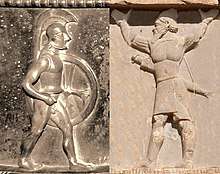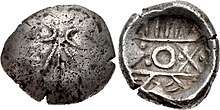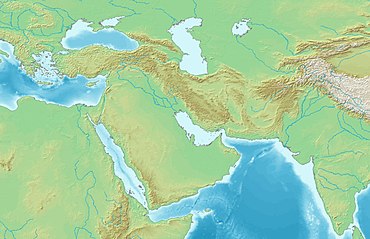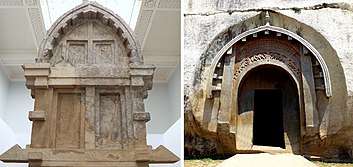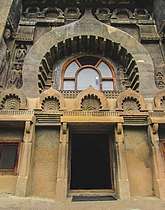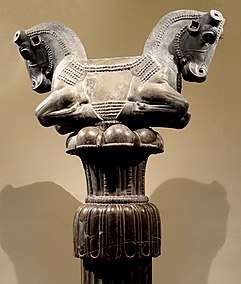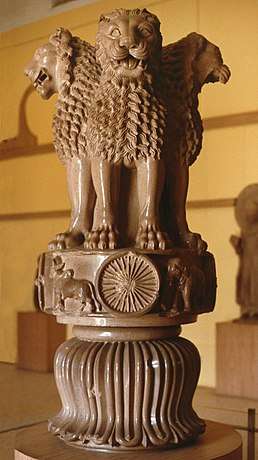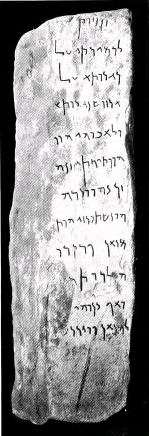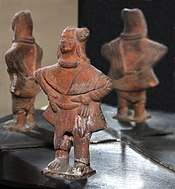Achaemenid conquest of the Indus Valley
The Achaemenid conquest of the Indus Valley refers to the Achaemenid military conquest and occupation of the territories of the North-western regions of the Indian subcontinent, from the 6th to 4th centuries BC. The conquest of the areas as far as the Indus river is often dated to the time of Cyrus the Great, in the period between 550-539 BCE.[1] The first secure epigraphic evidence, given by the Behistun Inscription, gives a date before or about 518 BCE. Achaemenid penetration into the area of the Indian subcontinent occurred in stages, starting from northern parts of the River Indus and moving southward.[6] These areas of the Indus valley became formal Achaemenid satrapies as mentioned in several Achaemenid inscriptions. The Achaemenid occupation of the Indus Valley ended with the Indian campaign of Alexander the Great circa 323 BCE.[1] The Achaemenid occupation, although less successful than that of the later Greeks, Sakas or Kushans, had the effect of acquainting India to the outer world.[7]
| Achaemenid conquest of the Indus Valley | |||||||
|---|---|---|---|---|---|---|---|
| Part of the Conquests of Achaemenid Empire | |||||||
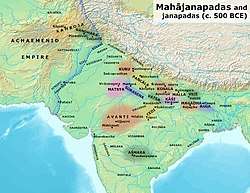 Eastern border of the Achaemenid Empire and the kingdoms and cities of ancient India (circa 500 BCE).[1][2][3][4] | |||||||
| |||||||
| Belligerents | |||||||
| Achaemenid Empire | Mahajanapadas | ||||||
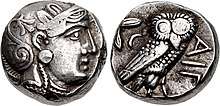
Background and invasion
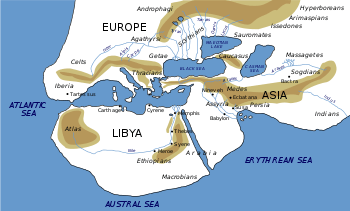
.jpg)
For millennia, the northwestern part of India had maintained some level of trade relations with the Near East. Finally, the Achaemenid Empire underwent a considerable expansion, both east and west, during the reign of Cyrus the Great (c.600–530 BC), leading the dynasty to take a direct interest into the region of northwestern India.[1]
- Cyrus the Great
The conquest is often thought to have started circa 535 BCE, during the time of Cyrus the Great (600-530 BCE).[8][9][1] Cyrus probably went as far as the banks of the Indus river and organized the conquered territories under the Satrapy of Gandara (Old Persian cuneiform: 𐎥𐎭𐎠𐎼, Gadāra, also transliterated as Gandāra since the nasal "n" before consonants was omitted in the Old Persian script, and simplified as Gandara)[10] according to the Behistun Inscription.[11] The Province was also referred to as Paruparaesanna (Greek: Parapamisadae) in the Babylonian and Elamite versions of the Behistun inscription.[11] The geographical extent of this province was wider than the Indian Gandhara.[12] Various accounts, such as those of Xenophon or Ctesias, who wrote Indica, also suggest that Cyrus conquered parts of India.[13][1] Another Indian Province was conquered named Sattagydia (𐎰𐎫𐎦𐎢𐏁, Thataguš) in the Behistun inscription. It was probably contiguous to Gandhara, but its actual location is uncertain. Fleming locates it between Arachosia and the middle Indus.[14] Fleming also mentions Maka, in the area of Gedrosia, as one of the Indian satrapies.[15]
- Darius I
A successor of Cyrus the Great, Darius I was back in 518 BCE. The date of 518 BCE is given by the Behistun inscription, and is also often the one given for the secure occupation of Gandhara in Punjab.[16] Darius I later conquered an additional province that he calls "Hidūš" in his inscriptions (Old Persian cuneiform: 𐏃𐎡𐎯𐎢𐏁, H-i-du-u-š, also transliterated as Hindūš since the nasal "n" before consonants was omitted in the Old Persian script, and simplified as Hindush), corresponding to the Indus Valley.[17][10][18] The Hamadan Gold and Silver Tablet inscription[19] of Darius I also refers to his conquests in India.[1]
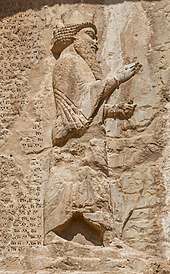
The exact area of the Province of Hindush is uncertain. Some scholars have described it as the middle and lower Indus Valley and the approximate region of modern Sindh,[20] but there is no known evidence of Achaemenid presence in this region, and deposits of gold, which Herodotus says was produced in vast quantities by this Province, are also unknown in the Indus delta region.[21] Alternatively, Hindush may have been the region of Taxila and Western Punjab, where there are indications that a Persian satrapy may have existed.[21] There are few remains of Achaemenid presence in the east, but, according to Fleming, the archaeological site of Bhir Mound in Taxila remains the "most plausible candidate for the capital of Achaemenid India", based on the fact that numerous pottery styles similar to those of the Achaemenids in the East have been found there, and that "there are no other sites in the region with Bhir Mound's potential".[22]
According to Herodotus, Darius I sent the Greek explorer Scylax of Caryanda to sail down the Indus river, heading a team of spies, in order to explore the course of the Indus river. After a periplus of 30 months, Scylax is said to have returned to Egypt near the Red Sea, and the seas between the Near East and India were made use of by Darius.[23][24]
Also according to Herodotus, the territories of Gandhara, Sattagydia, Dadicae and Aparytae formed the 7th province of the Achaemenid Empire for tax-payment purposes, while Indus (called Ἰνδός, "Indos" in Greek sources) formed the 20th tax region.
- Achaemenid army
The Achaemenid army was not uniquely Persian. Rather it was composed of many different ethnicities that were part of the vast Achaemenid Empire. The army included Bactrians, Sakas (Scythians), Parthians, Sogdians.[25] Herodotus gives a full list of the ethnicities of the Achaemenid army, in which are included Ionians (Greeks), and even Ethiopians.[26][25] These ethnicities are likely to have been included in the Achaemenid army which invaded India.[25]
The Persians may have later participated, together with Sakas and Greeks, in the campaigns of Chandragupta Maurya to gain the throne of Magadha circa 320 BCE. The Mudrarakshasa states that after Alexander's death, an alliance of "Shaka-Yavana-Kamboja-Parasika-Bahlika" was used by Chandragupta Maurya in his campaign to take the throne in Magadha and found the Mauryan Empire.[27][28][29] The Sakas were the Scythians, the Yavanas were the Greeks, and the Parasikas were the Persians.[28][30] David Brainard Spooner observed of Chandragupta Maurya that "it was with largely the Persian army that he won the throne of India."[29][27]
Inscriptions and accounts
on the Statue of Darius I
These events were recorded in the imperial inscriptions of the Achaemenids (the Behistun inscription and the Naqsh-i-Rustam inscription, as well as the accounts of Herodotus (483–431 BCE), and of the Hellenistic accounts of the Greek conquests in India (circa 320 BCE). The Greek Scylax of Caryanda, who had been appointed by Darius I to explore the Indian Ocean from the mouth of the Indus to Suez left an account, the Periplous, of which fragments from secondary sources have survived. Hecataeus of Miletus (circa 500 BCE) also wrote about the "Indus Satrapies" of the Achaemenids.
Behistun inscription
The 'DB' Behistun inscription[32] of Darius I (circa 510 BCE) mentions Gandara (𐎥𐎭𐎠𐎼, Gadāra) and the adjacent territory of Sattagydia (𐎰𐎫𐎦𐎢𐏁, Thataguš) as part of the Achaemenid Empire:
King Darius says: These are the countries which are subject unto me, and by the grace of Ahuramazda I became king of them: Persia [Pârsa], Elam [Ûvja], Babylonia [Bâbiruš], Assyria [Athurâ], Arabia [Arabâya], Egypt [Mudrâya], the countries by the Sea, Lydia [Sparda], the Greeks [Yauna (Ionia)], Media [Mâda], Armenia [Armina], Cappadocia [Katpatuka], Parthia [Parthava], Drangiana [Zraka], Aria [Haraiva], Chorasmia [Uvârazmîy], Bactria [Bâxtriš], Sogdia [Suguda], Gandara [Gadāra], Scythia [Saka], Sattagydia [Thataguš], Arachosia [Harauvatiš] and Maka [Maka]; twenty-three lands in all.
From the dating of the Behistun inscription, it is possible to infer that the Achaemenids first conquered the areas of Gandara and Sattagydia circa 518 BCE.
Statue of Darius inscriptions
Hinduš is also mentioned as one of 24 subject countries of the Achaemenid Empire, illustrated with the drawing of a kneeling subject and a hieroglyphic cartridge reading 𓉔𓈖𓂧𓍯𓇌 (h-n-d-wꜣ-y), on the Egyptian Statue of Darius I, now in the National Museum of Iran. Sattagydia also appears (𓐠𓂧𓎼𓍯𓍒, sꜣ-d-g-wꜣ-ḏꜣ, Sattagydia), and probably Gandara (𓉔𓃭𓐍𓂧𓇌, h-rw-ḫ-d-y, although this could be Arachosia), with their own illustrations.[35][31]
Apadana Palace foundation tablets
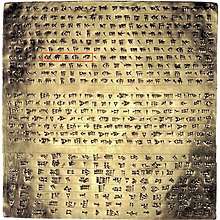
Four identical foundation tablets of gold and silver, found in two deposition boxes in the foundations of the Apadana Palace, also contained an inscription by Darius I in Old Persian cuneiform, which describes the extent of his Empire in broad geographical terms, from the Indus valley in the east to Lydia in the west, and from the Scythians beyond Sogdia in the north, to the African Kingdom of Kush in the south. This is known as the DPh inscription.[37][38] The deposition of these foundation tablets and the Apadana coin hoard found under them, is dated to circa 515 BCE.[37]
Darius the great king, king of kings, king of countries, son of Hystaspes, an Achaemenid. King Darius says: This is the kingdom which I hold, from the Sacae who are beyond Sogdia to Kush, and from Sind (Old Persian: 𐏃𐎡𐎭𐎢𐎺, "Hidauv", locative of "Hiduš", i.e. "Indus valley") to Lydia (Old Persian: "Spardâ") - [this is] what Ahuramazda, the greatest of gods, bestowed upon me. May Ahuramazda protect me and my royal house!
— DPh inscription of Darius I in the foundations of the Apadana Palace[39]
Naqsh-e Rustam inscription
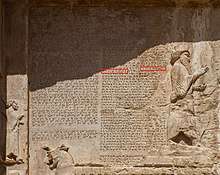
The DSe inscription[41] and DSm inscription[42] of Darius in Susa gives Thataguš (Sattagydia), Gadāra (Gandara) and Hiduš (Sind) among the nations that he rules.[41][31]
Hidūš (𐏃𐎡𐎯𐎢𐏁 in Old Persian cuneiform) also appears later as a Satrapy in the Naqsh-i-Rustam inscription at the end of the reign of Darius, who died in 486 BCE.[31] The DNa inscription[18] on Darius' tomb at Naqsh-i-Rustam near Persepolis records Gadāra (Gandāra) along with Hiduš and Thataguš (Sattagydia) in the list of satrapies.[43]
King Darius says: By the favor of Ahuramazda these are the countries which I seized outside of Persia; I ruled over them; they bore tribute to me; they did what was said to them by me; they held my law firmly; Media, Elam, Parthia, Aria, Bactria, Sogdia, Chorasmia, Drangiana, Arachosia, Sattagydia, Gandara (Gadāra), India (Hiduš), the haoma-drinking Scythians, the Scythians with pointed caps, Babylonia, Assyria, Arabia, Egypt, Armenia, Cappadocia, Lydia, the Greeks (Yauna), the Scythians across the sea (Sakâ), Thrace, the petasos-wearing Greeks [Yaunâ], the Libyans, the Nubians, the men of Maka and the Carians.
Strabo
The extent of Achaemenid territories is also affirmed by Strabo in his "Geography" (Book XV), describing the Persian holdings along the Indus:[46]
The geographical position of the tribes is as follows: along the Indus are the Paropamisadae, above whom lies the Paropamisus mountain: then, towards the south, the Arachoti: then next, towards the south, the Gedroseni, with the other tribes that occupy the seaboard; and the Indus lies, latitudinally, alongside all these places; and of these places, in part, some that lie along the Indus are held by Indians, although they formerly belonged to the Persians.
Achaemenid administration
The nature of the administration under the Achaemenids is uncertain. Even though the Indian provinces are called "satrapies" by convention, there is no evidence of there being any satraps in these provinces. When Alexander invaded the region, he did not encounter Achaemenid satraps in the Indian provinces, but local Indian rulers referred to as hyparchs ("Vice-Regents"), a term that connotes subordination to the Achaemenid rulers.[51] The local rulers may have reported to the satraps of Bactria and Arachosia.[51]
- Achaemenid lists of Provinces
Darius I listed three Indian provinces: Thataguš (Sattagydia), Gandâra (Gandhara) and Hidūš (Sind),[31] in which "Sind" should be understood as "Indus Valley".[52] The three regions remained represented among Achaemenid Provinces on all the tombs of the Achaemenid rulers after Darius, except for the last ruler Darius III who was vanquished by Alexander at Gaugamela, suggesting that the Indians were under Achaemenid dominion at least until 338 BCE, date of the end of the reign of Artaxerxes III, before the accession of Darius III, that is, less than 10 years before the campaigns of Alexander in the East and his victory at Gaugamela.[51] The last known appearance of Gandhara in name as an Achaemenid province is on the list of the tomb of Artaxerxes II, circa 358 BCE, date of his burial.[48][49][50]
- List of Herodotus
Herodotus (III-91 and III-94), gives a list with a slightly different structure, as some province which are presented separately in the Achaemenid inscriptions are grouped together by Herodotus when he described the tribute paid by each territory.[53][54][55] Herodotus presents Indos (Ἰνδός) as "the 20th province", while "the Sattagydae, Gandarii, Dadicae, and Aparytae" together form "the 7th Province".[55] According to historian A. T. Olmstead, the fact that some Achaemenid regions are grouped together in this list may have represented some loss of territory.[56]
The Hindūš province, remained loyal till Alexander's invasion.[57] Circa 400 BC, Ctesias of Cnidus related that the Persian king was receiving numerous gifts from the kings of "India" (Hindūš).[31][lower-alpha 1] Ctesias also reported Indian elephants and Indian mahouts making demonstrations of the elephant's strength at the Achaemenid court.[59]
By about 380 BC, the Persian hold on the region was weakening, but the area continued to be a part of the Achaemenid Empire until Alexander's invasion.[60]
Darius III (c. 380 – July 330 BC) still had Indian units in his army.[31] In particular he had 15 war elephants at the Battle of Gaugamela for his fight against Alexander the Great.[61]
 Indian soldiers on the tomb of Darius I (c.500 BCE)
Indian soldiers on the tomb of Darius I (c.500 BCE)_circa_480_BCE_in_the_Naqsh-e_Roastam_reliefs_of_Xerxes_I.jpg) Indian soldiers on the tomb of Xerxes I (c.480 BCE)
Indian soldiers on the tomb of Xerxes I (c.480 BCE) Indian soldiers on the tomb of Artaxerxes I (c.430 BCE)
Indian soldiers on the tomb of Artaxerxes I (c.430 BCE)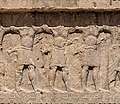 Indian soldiers on the tomb of Darius II (c.410 BCE)
Indian soldiers on the tomb of Darius II (c.410 BCE)_Upper_Relief_Indian_soldiers_with_labels.jpg) Indian soldiers on the tomb of Artaxerxes II (c.370 BCE)
Indian soldiers on the tomb of Artaxerxes II (c.370 BCE) Indian soldiers on the tomb of Artaxerxes III (c.340 BCE)
Indian soldiers on the tomb of Artaxerxes III (c.340 BCE)
Indian tributes
Apadana Palace

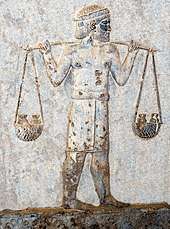
The reliefs at the Apadana Palace in Persepolis describe tribute bearers from 23 satrapies visiting the Achaemenid court. These are located at the southern end of the Apadana Staircase. Among the foreigners the Arabs, the Thracians, the Bactrians, the Indians (from the Indus valley area), the Parthians, the Cappadocians, the Elamites or the Medians. The Indians from the Indus valley are bare-chested, except for their leader, and barefooted and wear the dhoti. They bring baskets with vases inside, carry axes, and drive along a donkey.[63] One man in the Indian procession carries a small but visibly heavy load of four jars on a yoke, suggesting that he was carrying some of the gold dust paid by the Indians as tribute to the Achaemenid court.[62]
According to the Naqsh-e Rustam inscription of Darius I (circa 490 BCE), there were three Achaemenid Satrapies in the subcontinent: Sattagydia, Gandara, Hidūš.[44][64]
Tribute payments

The conquered area was the most fertile and populous region of the Achaemenid Empire. An amount of tribute was fixed according to the richness of each territory.[67][65] India was already fabled for its gold.
Herodotus (who makes several comments on India) published a list of tribute-paying nations, classifying them in 20 Provinces.[68][55] The Province of Indos (Ἰνδός, the Indus valley) formed the 20th Province, and was the richest and most populous of the Achaemenid Provinces.
The Indians ( Ἰνδῶν) made up the twentieth province. These are more in number than any nation known to me, and they paid a greater tribute than any other province, namely three hundred and sixty talents of gold dust.
According to Herodotus, the "Indians" ('Ινδοι, Indoi[69]), as separate from the Gandarei and the Sattagydians, formed the 20th taxation Province, and were required to supply gold dust in tribute to the Achaemenid central government for an amount of 360 Euboean talents (equivalent to about 8300 kg or 8.3 tons of gold annually, a volume of gold that would fit in a cube of side 75 cm).[67][65] The exchange rate between gold and silver at the time of Herodotus being 13 to 1, this was equal in value to the very large amount of 4680 Euboean talents of silver, equivalent to 3600 Babylonian talents of silver (equivalent in value to about 108 tons of silver annually).[67][65] The country of the "Indians" ('Ινδοι, Indoi) was the Achaemenid district paying the largest tribute, and alone represented 32% of the total tribute revenues of the whole Achaemenid Empire.[67][65][31] It also means that Indos was the richest Achaemenid region in the subcontinent, much richer than Gandara or Sattagydia.[31] However the amount of gold in question is quite enormous, so there is a possibility that Herodotus was mistaken and that his own sources actually only meant something like the gold equivalent of 360 Babylonian talents of silver.[21]
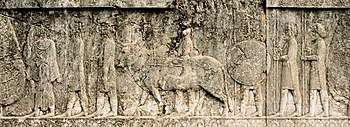
The territories of Gandara, Sattagydia, Dadicae (north-west of the Kashmir Valley) and the Aparytae (Afridis) are named separately, and were aggregated together for taxation purposes, forming the 7th Achaemenid Province, and paying overall a much lower tribute of 170 talents together (about 5151 kg, or 5.1 tons of silver), hence only about 1.5% of the total revenues of the Achaemenid Empire:[67][65]
The Sattagydae (Σατταγύδαι), Gandarii (Γανδάριοι), Dadicae, and Aparytae (Ἀπαρύται) paid together a hundred and seventy talents; this was the seventh province
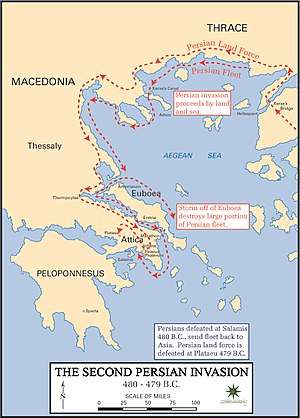
The Indians also supplied Yaka wood (teak) for the construction of Achaemenid palaces,[73][64] as well as war elephants such as those used at Gaugamela.[64] The Susa inscriptions of Darius explain that Indian ivory and teak were sold on Persian markets, and used in the construction of his palace.[1]
Contribution to Achaemenid war efforts
- Second Persian invasion of Greece (480-479 BCE)
Indians were employed in the Achaemenid army of Xerxes in the Second Persian invasion of Greece (480-479 BCE). All troops were stationned in Sardis, Lydia, during the winter of 481-480 BCE to prepare for the invasion.[74][75] In the spring of 480 BCE "Indian troops marched with Xerxes's army across the Hellespont".[15][76] It was the "first-ever force from India to fight on the continent of Europe", storming Greek troops at the Battle of Thermopylae in 480 BCE, and fighting as one of the main nations until the final Battle of Platea in 479 BCE.[77][78][79]
Herodotus, in his description of the multi-ethnic Achaemenid army invading Greece, described the equipment of the Indians:[76]
The Indians wore garments of tree-wool, and carried bows of reed and iron-tipped arrows of the same. Such was their equipment; they were appointed to march under the command of Pharnazathres son of Artabates.
— Herodotus VII 65
Herodotus also explains that the Indian cavalry under the Achaemenids had an equipment similar that of their foot soldiers:
The Indians were armed in like manner as their foot; they rode swift horses and drove chariots drawn by horses and wild asses.
— Herodotus VII 86
The Gandharis had a different equipment, akin to that of the Bactrians:
The Bactrians in the army wore a headgear most like to the Median, carrying their native bows of reed, and short spears. (...) The Parthians, Chorasmians, Sogdians, Gandarians, and Dadicae in the army had the same equipment as the Bactrians. The Parthians and Chorasmians had for their commander Artabazus son of Pharnaces, the Sogdians Azanes son of Artaeus, the Gandarians and Dadicae Artyphius son of Artabanus.
— Herodotus VII 64-66
- Destruction of Athens and Battle of Plataea (479 BCE)
After the first part of the campaign directly under the orders Xerxes I, the Indian troops are reported to have stayed in Greece as one of the 5 main nations among the 300,000 elite troops of General Mardonius. They fought in the last stages of the war, took part in the Destruction of Athens, but were finally vanquished at the Battle of Platea:[83]
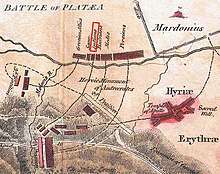
Mardonius there chose out first all the Persians called Immortals, save only Hydarnes their general, who said that he would not quit the king's person; and next, the Persian cuirassiers, and the thousand horse, and the Medes and Sacae and Bactrians and Indians, alike their footmen and the rest of the horsemen. He chose these nations entire; of the rest of his allies he picked out a few from each people, the goodliest men and those that he knew to have done some good service... Thereby the whole number, with the horsemen, grew to three hundred thousand men.
At the final Battle of Platea in 479 BCE, Indians formed one of the main corps of Achaemenid troops (one of "the greatest of the nations").[78][79][77][85] They were one of the main battle corps, positioned near the center of the Achaemenid battle line, between the Bactrians and the Sakae, facing against the enemy Greek troops of "Hermione and Eretria and Styra and Chalcis".[86][78] According to modern estimates, the Bactrians, Indians and Sakae probably numbered about 20,000 men altogether, whereas the Persian troops on their left amounted to about 40,000.[87] There were also Greek allies of the Persians, positioned on the right, whom Herodotus numbers at 50,000, a number which however might be "extravagant",[87] and is nowadays estimated to around 20,000.[88] Indians also supplied part of the cavalry, the total of which was about 5,000.[89][88]
- Depictions
Indian soldiers of the three territories of Gandara, Sattagydia (Tathagatus) and Hindush are shown, together with soldiers of all the other nations, supporting the throne of their Achaemenid ruler, at Naqsh-e Rostam on the tombs of Darius I, Xerxes I, Artaxerxes I and Darius II, and at Persepolis on the tombs of Artaxerxes II and Artaxerxes III. The last Achaemenid ruler Darius III never had time to finish his own tomb due to his hasty defeat by Alexander the Great, and therefore does not have such depictions.[51][72] The soldiers from India are characterized by their particular clothing, only composed of a loin cloth and sandals, with bare upper body, in contrast to all the other ethnicities of the Achaemenid army, who are fully clothed, and in contrast also to the neighbouring provinces of Bactria or Arachosia, who are also fully clothed.[51]
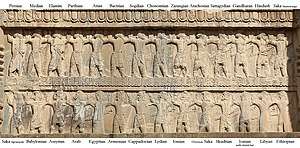
The presence of the three ethnicities of Indian soldiers on the all the tombs of the Achaemenid rulers after Darius, except for the last ruler Darius III who was vanquished by Alexander at Gaugamela, suggest that the Indians were under Achaemenid dominion at least until 338 BCE, date of the end of the reign of Artaxerxes III, before the accession of Darius III, that is, less than 10 years before the campaigns of Alexander in the East and his victory at Gaugamela.[51]
- Indians at the Battle of Gaugamela (331 BCE)
According to Arrian, Indian troops were still deployed under Darius III at the Battle of Gaugamela (331 BCE). He explains that Darius III "obtained the help of those Indians who bordered on the Bactrians, together with the Bactrians and Sogdianians themselves, all under the command of Bessus, the Satrap of Bactria".[51] The Indians in questions were probably from the area of Gandara.[51] Indian "hill-men" are also said by Arrian to have joined the Arachotians under Satrap Barsentes, and are thought to have been either the Sattagydians or the Hindush.[51]
Fifteen Indian war elephants were also part of the army of Darius III at Gaugamela.[61] They had specifically been brought from India.[91] Still, it seems they did not participate to the final battle, probably because of fatigue.[61] This was a relief for the armies of Alexander, who had no previous experience of combat against war elephants.[92] The elephants were captured with the baggage train by the Greeks after the engagement.[93]
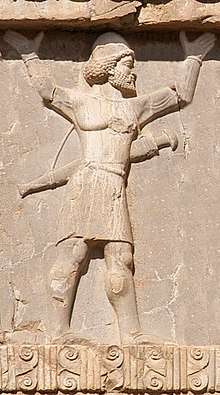 Gandaran soldier of the Achaemenid army, circa 480 BCE. Xerxes I tomb.
Gandaran soldier of the Achaemenid army, circa 480 BCE. Xerxes I tomb.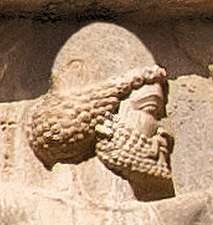 Gandaran soldier (enhanced detail).
Gandaran soldier (enhanced detail).
Sattagydian soldier of the Achaemenid army, circa 480 BCE. Xerxes I tomb. 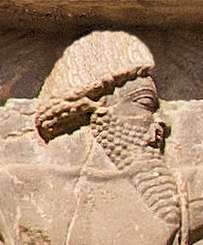 Sattagydian soldier (enhanced detail).
Sattagydian soldier (enhanced detail).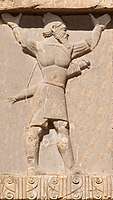 Hindush soldier of the Achaemenid army, circa 480 BCE. Xerxes I tomb.
Hindush soldier of the Achaemenid army, circa 480 BCE. Xerxes I tomb.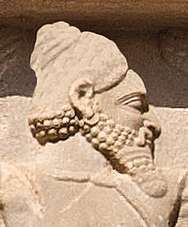 Hindush soldier (enhanced detail).
Hindush soldier (enhanced detail).
Greek and Achaemenid coinage
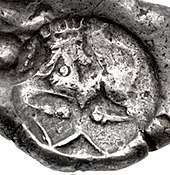
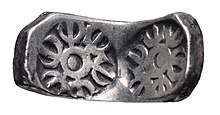
Coin finds in the Chaman Hazouri hoard in Kabul, or the Shaikhan Dehri hoard in Pushkalavati in Gandhara, near Charsadda, as well as in the Bhir Mound hoard in Taxila, have revealed numerous Achaemenid coins as well as many Greek coins from the 5th and 4th centuries BCE which circulated in the area, at least as far as the Indus during the reign of the Achaemenids, who were in control of the areas as far as Gandhara.[99][100][96][101]
Kabul and Bhir Mound hoards
The Kabul hoard, also called the Chaman Hazouri, Chaman Hazouri or Tchamani-i Hazouri hoard,[99] is a coin hoard discovered in the vicinity of Kabul, Afghanistan. The hoard, discovered in 1933, contained numerous Achaemenid coins as well as many Greek coins from the 5th and 4th centuries BCE.[96] Approximately one thousand coins were in the hoard.[99][100] The hoard is dated to approximately 380 BCE as no coins in the hoard were later than that date.[102]
This numismatic discovery has been very important in studying and dating the history of coinage of India, since it is one of the very rare instances when punch-marked coins can actually be dated, due to their association with known and dated Greek and Achaemenid coins in the hoard.[103] The hoard supports the view that punch-marked coins existed in 360 BCE, as suggested by literary evidence.[103]
Daniel Schlumberger also considers that punch-marked bars, similar to the many punch-marked bars found in north-western India, initially originated in the Achaemenid Empire, rather than in the Indian heartland:
“The punch-marked bars were up to now considered to be Indian (...) However the weight standard is considered by some expert to be Persian, and now that we see them also being uncovered in the soil of Afghanistan, we must take into account the possibility that their country of origin should not be sought beyond the Indus, but rather in the oriental provinces of the Achaemenid Empire"
Modern numismatists now tend to consider the Achaemenid punch-marked coins as the precursors of the Indian punch-marked coins.[104][105]
Pushkalavati hoard
In 2007, a small coin hoard was discovered at the site of ancient Pushkalavati (the Shaikhan Dehri hoard) near Charsada in Pakistan. The hoard contained a tetradrachm minted in Athens circa 500/490-485/0 BCE, together with a number of local types as well as silver cast ingots. The hoard contained a tetradrachm minted in Athens circa 500/490-485/0 BCE, typically used as a currency for trade in the Achaemenid Empire, together with a number of local types as well as silver cast ingots. The Athens coin is the earliest known example of its type to be found so far to the east.[106][107]
According to Joe Cribb, these early Greek coins were at the origin of Indian punch-marked coins, the earliest coins developed in India, which used minting technology derived from Greek coinage.[96]
Influence of Achaemenid culture in the Indian subcontinent
Cultural exchanges: Taxila
Taxila (site of Bhir Mound), the "most plausible candidate for the capital of Achaemenid India",[15] was at the crossroad of the main trade roads of Asia, was probably populated by Persians, Greeks and other people from throughout the Achaemenid Empire.[108][109][110] As reported by Strabo (XV, 1, 62),[111] when Alexander the Great was in Taxila, one of his companions named Aristobulus, noticed that in the city the dead were being fed to the vultures, a clear allusion to the presence of Zoroastrianism.[112] The renowned University of Taxila became the greatest learning centre in the region, and allowed for exchanges between people from various cultures.[113]
- Followers of the Buddha
Several contemporaries, and close followers, of the Buddha are said to have studied in Achaemenid Taxila: King Pasenadi of Kosala,[114] a close friend of the Buddha, Bandhula, the commander of Pasedani's army, Aṅgulimāla, a close follower of the Buddha, and Jivaka, court doctor at Rajagriha and personal doctor of the Buddha.[115][116] According to Stephen Batchelor, the Buddha may have been influenced by the experiences and knowledge acquired by some of his closest followers in Taxila.[117]
- Pāṇini
The 5th century BCE grammarian Pāṇini lived in an Achaemenid environment.[118][119][120] He is said to have been born in the north-west, in Shalatula near Attock to the north-west of Taxila, in what was then a satrapy of the Achaemenid Empire following the Achaemenid conquest of the Indus Valley, which technically made him a Persian subject.[118][119][120]
- Kautilya and Chandragupta Maurya
Kautilya, the influential Prime Minister of Chandragupta Maurya, is also said to have been a professor teaching in Taxila.[121] According to Buddhist legend, Kautilya brought Chandragupta Maurya, the future founder of the Mauryan Empire to Taxila as a child, and had him educated there in "all the sciences and arts" of the period, including military sciences, for a period of 7 to 8 years.[122] These legends match Plutarch's assertion that Alexander the Great met with the young Chandragupta while campaigning in the Punjab.[122][123]
Astronomical and astrological knowledge was also probably transmitted to India from Babylon during the 5th century BCE as a consequence of the Achaemenid presence in the sub-continent.[124][125]
Scientific knowledge
According to David Pingree, elements of Achaemenid scientific knowledge, particularly works on omens and astronomy, were adopted by India from the 5th century BCE:[126]
"India today is estimated to have about thirty million manuscripts, the largest body of handwritten reading material anywhere in the world. The literate culture of Indian science goes back to at least the fifth century B.C. ... as is shown by the elements of Mesopotamian omen literature and astronomy that entered India at that time."[126]
Palatial art and architecture: Pataliputra
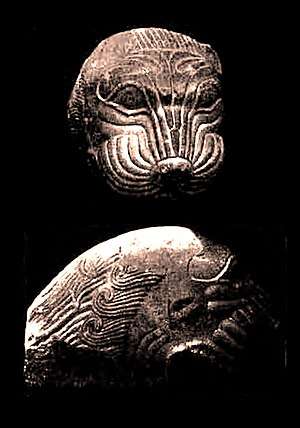
Various Indian artefacts tend to suggest some Perso-Hellenistic artistic influence in India, mainly felt during the time of the Mauryan Empire.[1] The sculpture of the Masarh lion, found near the Maurya capital of Pataliputra, raises the question of the Achaemenid and Greek influence on the art of the Maurya Empire, and on the western origins of stone carving in India. The lion is carved in Chunar sandstone, like the Pillars of Ashoka, and its finish is polished, a feature of the Maurya sculpture.[127] According to S.P. Gupta, the sculptural style is unquestionably Achaemenid.[127] This is particularly the case for the well-ordered tubular representation of whiskers (vibrissas) and the geometrical representation of inflated veins flush with the entire face.[127] The mane, on the other hand, with tufts of hair represented in wavelets, is rather naturalistic.[127] Very similar examples are however known in Greece and Persepolis.[127] It is possible that this sculpture was made by an Achaemenid or Greek sculptor in India and either remained without effect, or was the Indian imitation of a Greek or Achaemenid model, somewhere between the fifth century B.C. and the first century B.C., although it is generally dated from the time of the Maurya Empire, around the 3rd century B.C.[127]
The Pataliputra palace with its pillared hall shows decorative influences of the Achaemenid palaces and Persepolis and may have used the help of foreign craftsmen.[128][1] Mauryan rulers may have even imported craftsmen from abroad to build royal monuments.[129] This may be the result of the formative influence of craftsmen employed from Persia following the disintegration of the Achaemenid Empire after the conquests of Alexander the Great.[130][131] The Pataliputra capital, or also the Hellenistic friezes of the Rampurva capitals, Sankissa, and the diamond throne of Bodh Gaya are other examples.[132]
The renowned Mauryan polish, especially used in the Pillars of Ashoka, may also have been a technique imported from the Achaemenid Empire.[1]
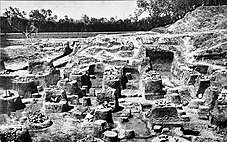 Ruins of pillared hall at Kumrahar site at Pataliputra.
Ruins of pillared hall at Kumrahar site at Pataliputra.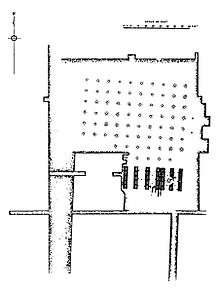 Plan of the 80-column pillared hall in Pataliputra.
Plan of the 80-column pillared hall in Pataliputra.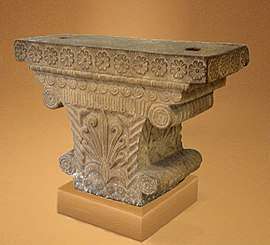 The Pataliputra capital, generally described as "Perso-Hellenistic".
The Pataliputra capital, generally described as "Perso-Hellenistic".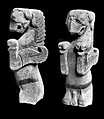
 Lotus motifs in Pataliputra.
Lotus motifs in Pataliputra.
Rock-cut architecture
The similarity of the 4th century BCE Lycian barrel-vaulted tombs, such as the tomb of Payava, in the western part of the Achaemenid Empire, with the Indian architectural design of the Chaitya (starting at least a century later from circa 250 BCE, with the Lomas Rishi caves in the Barabar caves group), suggests that the designs of the Lycian rock-cut tombs travelled to India along the trade routes across the Achaemenid Empire.[134][135]
Early on, James Fergusson, in his " Illustrated Handbook of Architecture", while describing the very progressive evolution from wooden architecture to stone architecture in various ancient civilizations, has commented that "In India, the form and construction of the older Buddhist temples resemble so singularly these examples in Lycia".[136] The structural similarities, down to many architectural details, with the Chaitya-type Indian Buddhist temple designs, such as the "same pointed form of roof, with a ridge", are further developed in The cave temples of India.[137] The Lycian tombs, dated to the 4th century BCE, are either free-standing or rock-cut barrel-vaulted sarcophagi, placed on a high base, with architectural features carved in stone to imitate wooden structures. There are numerous rock-cut equivalents to the free-standing structures and decorated with reliefs.[138][139][140] Fergusson went on to suggest an "Indian connection", and some form of cultural transfer across the Achaemenid Empire.[135] The ancient transfer of Lycian designs for rock-cut monuments to India is considered as "quite probable".[134]
Art historian David Napier has also proposed a reverse relationship, claiming that the Payava tomb was a descendant of an ancient South Asian style, and that Payava may actually have been a Graeco-Indian named "Pallava".[141]
Monumental columns: the Pillars of Ashoka
Regarding the Pillars of Ashoka, there has been much discussion of the extent of influence from Achaemenid Persia,[142] since the column capitals supporting the roofs at Persepolis have similarities, and the "rather cold, hieratic style" of the Sarnath Lion Capital of Ashoka especially shows "obvious Achaemenid and Sargonid influence".[143]
Hellenistic influence has also been suggested.[144] In particular the abaci of some of the pillars (especially the Rampurva bull, the Sankissa elephant and the Allahabad pillar capital) use bands of motifs, like the bead and reel pattern, the ovolo, the flame palmettes, lotuses, which likely originated from Greek and Near-Eastern arts.[145] Such examples can also be seen in the remains of the Mauryan capital city of Pataliputra.

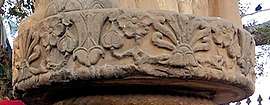 Frieze of Sankissa.
Frieze of Sankissa. Frieze of the diamond throne of Bodh Gaya.
Frieze of the diamond throne of Bodh Gaya.
Aramaic language and script
The Aramaic language, official language of the Achaemenid Empire, started to be used in the Indian territories.[146] Some of the Edicts of Ashoka in the north-western areas of Ashoka's territory, in modern Pakistan and Afghanistan, used Aramaic (the official language of the former Achaemenid Empire), together with Prakrit and Greek (the language of the neighbouring Greco-Bactrian kingdom and the Greek communities in Ashoka's realm).[147]
The Indian Kharosthi script shows a clear dependency on the Aramaic alphabet but with extensive modifications to support the sounds found in Indic languages.[1][148] One model is that the Aramaic script arrived with the Achaemenid Empire's conquest of the Indus River (modern Pakistan) in 500 BCE and evolved over the next 200+ years, reaching its final form by the 3rd century BCE where it appears in some of the Edicts of Ashoka.[146][1]
Edicts of Ashoka
The Edicts of Ashoka (circa 250 BCE) may show Achaemenid influences, including formulaic parallels with Achaemenid inscriptions, presence of Iranian loanwords (in Aramaic inscriptions), and the very act of engraving edicts on rocks and mountains (compare for example Behistun inscription).[149][150] To describe his own edicts, Ashoka used the word Lipī (𑀮𑀺𑀧𑀺), now generally simply translated as "writing" or "inscription". It is thought the word "lipi", which is also orthographed "dipi" (𐨡𐨁𐨤𐨁) in the two Kharosthi versions of the rock edicts,[lower-alpha 2] comes from an Old Persian prototype dipî (𐎮𐎡𐎱𐎡) also meaning "inscription", which is used for example by Darius I in his Behistun inscription,[lower-alpha 3] suggesting borrowing and diffusion.[151][152][153] There are other borrowings of Old Persian terms for writing-related words in the Edicts of Ashoka, such as nipista or nipesita (𐨣𐨁𐨤𐨁𐨯𐨿𐨟, "written" and "made to be written") in the Kharoshthi version of Major Rock Edict No.4, which can be related to the word nipištā (𐎴𐎡𐎱𐎡𐏁𐎫𐎠, "written") from the daiva inscription of Xerxes at Persepolis.[154]
Several of the Edicts of Ashoka, such as the Kandahar Bilingual Rock Inscription or the Taxila inscription were written in Aramaic, one of the official languages of the former Achaemenid Empire.[155]
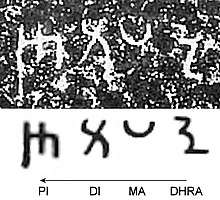 The word Dipi ("Edict") in the Edicts of Ashoka, identical with the Achaemenid word for "writing".[156]
The word Dipi ("Edict") in the Edicts of Ashoka, identical with the Achaemenid word for "writing".[156]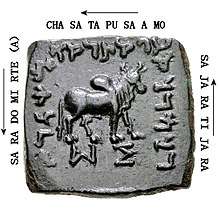 The Kharoshthi script is generally considered as a development from Aramaic.
The Kharoshthi script is generally considered as a development from Aramaic. The Kandahar Bilingual Rock Inscription of Ashoka (circa 256 BCE) in Greek and Aramaic.
The Kandahar Bilingual Rock Inscription of Ashoka (circa 256 BCE) in Greek and Aramaic.
Figurines of Persian foreigners in Mathura (4th-2nd century CE)
Some relatively high quality terracotta statuettes have been recovered from the Mauryan Empire strata in the excavations of Mathura in northern India.[158] Most of these terracottas show what appears to be female deities or mother goddesses.[159][160] However, several figures of foreigners also appear in the terracottas from the 4th to the 2nd century BCE, which are either described simply as "foreigners" or Persian or Iranian because of their foreign features.[157][161][162] These figurines might reflect the increased contacts of Indians with Iranian people during this period.[161] Several of these seem to represent foreign soldiers who visited India during the Mauryan period and influenced modellers in Mathura with their peculiar ethnic features and uniforms.[163] One of the terracotta statuettes, a man nicknamed the "Persian nobleman" and dated to the 2nd century BCE, can be seen wearing a coat, scarf, trousers and a turban.[164][165][166][157]
Religion
According to Ammianus Marcellinus,[167] a 4th-century CE Roman author, Hystaspes, the father of Darius I, studied under the Brahmins in India, thus contributing to the development of the religion of the Magi (Zoroastrianism):[168]
"Hystaspes, a very wise monarch, the father of Darius. Who while boldly penetrating into the remoter districts of upper India, came to a certain woody retreat, of which with its tranquil silence the Brahmans, men of sublime genius, were the possessors. From their teaching he learnt the principles of the motion of the world and of the stars, and the pure rites of sacrifice, as far as he could; and of what he learnt he infused some portion into the minds of the Magi, which they have handed down by tradition to later ages, each instructing his own children, and adding to it their own system of divination".
In ancient sources, Hystapes is sometimes considered as identical with Vishtaspa (the Avestan and Old Persian name for Hystapes), an early patron of Zoroaster.[168]
Historically, the life of the Buddha also coincided with the Achaemenid conquest of the Indus Valley.[170] The Achaemenid occupation of the areas of Gandara and Hinduš, which was to last for about two centuries, was accompanied by Achaemenid religions, reformed Mazdaism or early Zoroastrianism, to which Buddhism might also have in part reacted.[170] In particular, the ideas of the Buddha may have partly consisted in a rejection of the "absolutist" or "perfectionist" ideas contained in these Achaemenid religions.[170]
Still, according to Christopher I. Beckwith, commenting on the content of the Edicts of Ashoka, the early Buddhist concepts of karma, rebirth, and affirming that good deeds with be rewarded in this life and the next, in Heaven, probably find their origin in Achaemenid Mazdaism, which had been introduced in India from the time of the Achaemenid conquest of Gandara.[171]
See also
- Persian Immortals
Notes
- Ctesias: "The Indians also include this substance among their most precious gifts for the Persian king who receives it as a prize revered above all others."[58]
- For example, according to Hultzsch, the first line of the First Edict at Shahbazgarhi (or at Mansehra) reads: "(Ayam) Dhrama-dipi Devanapriyasa Raño likhapitu" ("This Dharma-Edicts was written by King Devanampriya" Inscriptions of Asoka. New Edition by E. Hultzsch (in Sanskrit). 1925. p. 51.
This appears in the reading of Hultzsch's original rubbing of the Kharoshthi inscription of the first line of the First Edict at Shahbazgarhi. - For example Column IV, Line 89
References
- Sen, Ancient Indian History and Civilization 1999, pp. 116–117.
- Philip's Atlas of World History (1999)
- O'Brien, Patrick Karl (2002). Atlas of World History. Oxford University Press. p. 43. ISBN 9780195219210.
- Barraclough, Geoffrey (1989). The Times Atlas of World History. Times Books. p. 79. ISBN 9780723009061.
- Errington, Elizabeth; Trust, Ancient India and Iran; Museum, Fitzwilliam (1992). The Crossroads of Asia: transformation in image and symbol in the art of ancient Afghanistan and Pakistan. Ancient India and Iran Trust. p. 56. ISBN 9780951839911.
- (Fussman, 1993, p. 84). "This is inferred from the fact that Gandhara (OPers. Gandāra) is already mentioned at Bisotun, while the toponym Hinduš (Sindhu) is added only in later inscriptions."
- Sen, Sailendra Nath (1999). Ancient Indian History and Civilization. New Age International. p. 118. ISBN 9788122411980.
- Kerr, Gordon (2017). A Short History of India: From the Earliest Civilisations to Today's Economic Powerhouse (in German). Oldcastle Books. p. PT16. ISBN 9781843449232.
- Thapar, Romila (1990). A History of India. Penguin UK. p. 422. ISBN 9780141949765.
- Some sounds are omitted in the writing of Old Persian, and are shown with a raised letter.Old Persian p.164Old Persian p.13. In particular Old Persian nasals such as "n" were omitted in writing before consonants Old Persian p.17Old Persian p.25
- Perfrancesco Callieri, INDIA ii. Historical Geography, Encyclopaedia Iranica, 15 December 2004.
- Eggermont, Alexander's Campaigns in Sind and Baluchistan 1975, p. 177: "One should, therefore, be careful to distinguish the limited geographical unit of Gandhāra from the political one bearing the same name."
- Tauqeer Ahmad, University of the Punjab, Lahore, South Asian Studies, A Research Journal of South Asian Studies, Vol. 27, No. 1, January–June 2012, pp. 221-232 p.222
- FLEMING, DAVID (1993). "Where was Achaemenid India?". Bulletin of the Asia Institute. 7: 67–72. JSTOR 24048427.
- FLEMING, DAVID (1993). "Where was Achaemenid India?". Bulletin of the Asia Institute. 7: 70. JSTOR 24048427.
- Marshall, John (1975) [1951]. Taxila: Volume I. Delhi: Motilal Banarsidass. pp. 83.
- Waters, Matt (2014). Ancient Persia: A Concise History of the Achaemenid Empire, 550–330 BCE. Cambridge University Press. p. 82. ISBN 9781107009608.
- DNa - Livius.
- Hamadan Gold and Silver Tablet inscription
- Dandamaev, A Political History of the Achaemenid Empire 1989, p. 147; Neelis, Early Buddhist Transmission and Trade Networks 2010, pp. 96–97; Sen, Sailendra Nath (1999). Ancient Indian History and Civilization. New Age International. p. 117. ISBN 9788122411980.
- "The region was soon to appear as Hindūš in the Old Persian inscriptions... Transparent though the name appears at first sight, its location is not without problems. Foucher, Kent and many subsequent writers have identified Hindūš with its ethymological equivalent , Sind, thereby placing it on the lower Indus towards the delta. However (...) no material evidence of Achaemenid activity in this region is so far available. (...) There seems no evidence at present of gold production in the Indus delta, so this detail seems to weight against the location of the Hindūš province in Sind. (...) The alternative location to Sind for an Achaemenid province of Hindūš is naturally at Taxila and in the West Punjab, where there are indications that a Persian satrapy may have existed, though no clear evidence of its name." in Cambridge Ancient History. Cambridge University Press. 2002. pp. 203–204. ISBN 9780521228046.
- FLEMING, DAVID (1993). "Where was Achaemenid India?". Bulletin of the Asia Institute. 7: 69. JSTOR 24048427.
- Parker, Grant (2008). The Making of Roman India. Cambridge University Press. p. 15. ISBN 9780521858342.
- Olmstead, History of the Persian Empire 1948, pp. 144–145.
- Beckwith, Christopher I. (2015). Greek Buddha: Pyrrho's Encounter with Early Buddhism in Central Asia. Princeton University Press. p. 5. ISBN 9781400866328.
- Herodotus VII 65
- Mookerji, Radhakumud (1966). Chandragupta Maurya and His Times. Motilal Banarsidass. p. 27. ISBN 9788120804050.; Mookerji, Radha Kumud (1957). "The Foundation of the Mauryan Empire". In K. A. Nilakanta Sastri (ed.). A Comprehensive History of India, Volume 2: Mauryas and Satavahanas. Orient Longmans. p. 4.: "The Mudrarakshasa further informs us that his Himalayan alliance gave Chandragupta a composite army ... Among these are mentioned the following : Sakas, Yavanas (probably Greeks), Kiratas, Kambojas, Parasikas and Bahlikas."
- Shashi, Shyam Singh (1999). Encyclopaedia Indica: Mauryas. Anmol Publications. p. 134. ISBN 9788170418597.: "Among those who helped Chandragupta in his struggle against the Nandas, were the Sakas (Scythians), Yavanas (Greeks), and Parasikas (Persians)"
- D. B. Spooner (1915). "The Zoroastrian Period of Indian History" (PDF). Journal of the Royal Asiatic Society of Great Britain and Ireland. 47 (3): 416–417. doi:10.1017/S0035869X00048437. JSTOR 25189338.: "After Alexander's death, when Chandragupta marched on Magada, it was with largely the Persian army that he won the throne of India. The testimony of the Mudrarakshasa is explicit on this point, and we have no reason to doubt its accuracy in matter[s] of this kind."
- Mookerji, Radhakumud (1966). Chandragupta Maurya and His Times. Motilal Banarsidass. p. 210. ISBN 9788120804050.
- "INDIA RELATIONS: ACHAEMENID PERIOD – Encyclopaedia Iranica". www.iranicaonline.org.
- Behistun T 02 - Livius.
- King, L. W. (Leonard William); Thompson, R. Campbell (Reginald Campbell) (1907). The sculptures and inscription of Darius the Great on the Rock of Behistûn in Persia : a new collation of the Persian, Susian and Babylonian texts. London : Longmans. p. 3.
- Sagar, Krishna Chandra (1992). Foreign Influence on Ancient India. Northern Book Centre. p. 21. ISBN 9788172110284.
- "Susa, Statue of Darius - Livius". www.livius.org.
- Also described here
- Zournatzi, Antigoni (2003). "THE APADANA COIN HOARDS, DARIUS I, AND THE WEST". American Journal of Numismatics (1989-). 15: 1–28. JSTOR 43580364.
- Persepolis : discovery and afterlife of a world wonder. 2012. pp. 171–181.
- DPh inscription, also Photographs of one of the gold plaques
- Livius DNa inscription
- DSe - Livius.
- DSm inscription
- Sagar, Krishna Chandra (1992). Foreign Influence on Ancient India. Northern Book Centre. p. 20. ISBN 9788172110284.
- "DNa - Livius". www.livius.org.
- Alcock, Susan E.; Alcock, John H. D'Arms Collegiate Professor of Classical Archaeology and Classics and Arthur F. Thurnau Professor Susan E.; D'Altroy, Terence N.; Morrison, Kathleen D.; Sinopoli, Carla M. (2001). Empires: Perspectives from Archaeology and History. Cambridge University Press. p. 105. ISBN 9780521770200.
- Briant, Pierre (2002). From Cyrus to Alexander: A History of the Persian Empire. Eisenbrauns. p. 756. ISBN 978-1-57506-120-7.
- "Strabo Geography, Book XV, Chapter 2, 9". penelope.uchicago.edu.
- Olmstead, History of the Persian Empire 1948, pp. 291–292: "The Gandarians thus make their last appearance as Persian tribute paying subjects in the lists of Artaxerxes, though the land continued to be known under the name of Gandhara down to classic Indian times."
- Inscription A2Pa of Artaxerxes II
- Lecoq, Pierre. Les inscriptions de la perse achemenide (1997) (in French). pp. 271–272.
- Magee et al., The Achaemenid Empire in South Asia and Recent Excavations 2005, pp. 713-714.
- Tola, Fernando (1986). "India and Greece before Alexander". Annals of the Bhandarkar Oriental Research Institute. Annals of the Bhandarkar Oriental Research Institute Vol. 67, No. 1/4. 67 (1/4): 159–194. JSTOR 41693244.CS1 maint: location (link)
- Olmstead, History of the Persian Empire 1948, pp. 291–292
- Herodotus III 91, Herodotus III 94
- Mitchiner, The Ancient & Classical World 1978, p. 44.
- Olmstead, History of the Persian Empire 1948, pp. 291–292: "...the official tribute list incorporated by Herodotus shows decided administrative change. As under Cyrus, there were again twenty satrapies, but the larger number of Darius had been reduced by the union of some hitherto separate. This process, already to be detected in the army list of Xerxes, but accelerated in the tribute list of Artaxerxes, again suggests actual loss of territory. (25 lines later).... Two satrapies are united in the case of the Sattagydians, Gandarians, Dadicae, and Aparytae, whose tribute was 170 talents."
- Olmstead, History of the Persian Empire 1948, pp. 291–292.
- The Complete Fragments of Ctesias of Cnidus. pp. 120–121.
- The Complete Fragments of Ctesias of Cnidus. p. Page 116 Fragment F45bα) and Page 219 Note F45bα).
- The hypothesis that the region had already become independent by the end of the reign of Darius I or during the reign of Artaxerxes II (Chattopadhyaya, 1974, pp. 25-26) appears to be contradicted by Ctesias’s reference to gifts received from the kings of India and by the fact that even Darius III still had some Indian units in his army (Briant, 1996, pp. 699, 774). At the time of the arrival of the Alexander's Macedonian army in the Indus Valley, there is no mention of officers of the Persian kings in India; but this does not mean (Dittmann, 1984, p. 185) that the Achaemenids had no power there. Other data indicate that they still exercised control over the area, although in ways that differed from those of Darius I’s time (Briant, 1996, pp. 776-78).
- Kistler, John M. (2007). War Elephants. U of Nebraska Press. p. 29. ISBN 978-0803260047.
- "Furthermore the second member of Delegation XVIII is carrying four small but evidently heavy jars on a yoke, probably containing the gold dust which was the tribute paid by the Indians." in Iran, Délégation archéologique française en (1972). Cahiers de la Délégation archéologique française en Iran. Institut français de recherches en Iran (section archéologique). p. 146.
- André-Salvini, Béatrice (2005). Forgotten Empire: The World of Ancient Persia. University of California Press. ISBN 9780520247314.
- Bosworth, A. B. (1996). Alexander and the East : The Tragedy of Triumph: The Tragedy of Triumph. Clarendon Press. p. 154. ISBN 9780191589454.
- Herodotus Book III, 89-95
- Archibald, Zosia; Davies, John K.; Gabrielsen, Vincent (2011). The Economies of Hellenistic Societies, Third to First Centuries BC. Oxford University Press. p. 404. ISBN 9780199587926.
- Archibald, Davies & Gabrielsen, The Economies of Hellenistic Societies 2011, p. 404.
- Herodotus III, 89
- 'Ινδοι, Greek Word Study Tool, Tufts University
- Nations of the soldiers on the tombs, Walser. Also
- The Achaemenid Empire in South Asia and Recent Excavations in Akra in Northwest Pakistan Peter Magee, Cameron Petrie, Robert Knox, Farid Khan, Ken Thomas p.713
- NAQŠ-E ROSTAM – Encyclopaedia Iranica.
- DSf inscription
- Stoneman, Richard (2015). Xerxes: A Persian Life. Yale University Press. p. 118. ISBN 9780300180077.
- Herodotus. LacusCurtius • Herodotus — Book VII: Chapters 1‑56. pp. VII-26.
- Beckwith, Christopher I. (2015). Greek Buddha: Pyrrho's Encounter with Early Buddhism in Central Asia. Princeton University Press. p. 7. ISBN 9781400866328.
- Daniélou, Alain (2003). A Brief History of India. Simon and Schuster. p. 67. ISBN 9781594777943.
- "A Sindhu contingent formed a part of his army which invaded Greece and stormed the defile at Thermopylae in 480 BC, thus becoming the first ever force from India to fight on the continent of Europe. It, apparently, distinguished itself in battle because it was followed by another contingent which formed a part of the Persian army under Mardonius which lost the battle of Platea"Sandhu, Gurcharn Singh (2000). A military history of ancient India. Vision Books. p. 179.
- LacusCurtius • Herodotus — Book IX: Chapters 1‑89. pp. IX-32.
- Freeman, Charles (2014). Egypt, Greece, and Rome: Civilizations of the Ancient Mediterranean. Oxford University Press. p. 154. ISBN 9780199651917.
- Naqs-e Rostam – Encyclopaedia Iranica.
- Naqs-e Rostam – Encyclopaedia Iranica List of nationalities of the Achaemenid military with corresponding drawings.
- Tola, Fernando (1986). "India and Greece before Alexander". Annals of the Bhandarkar Oriental Research Institute. Annals of the Bhandarkar Oriental Research Institute Vol. 67, No. 1/4. 67 (1/4): 165. JSTOR 41693244.CS1 maint: location (link)
- LacusCurtius • Herodotus — Book VIII: Chapters 97‑144. p. Herodotus VIII, 113.
- Roy, Kaushik (2015). Warfare in Pre-British India – 1500BCE to 1740CE. Routledge. p. 28. ISBN 9781317586920.
- LacusCurtius • Herodotus — Book IX: Chapters 1‑89. pp. IX-31.
- Shepherd, William (2012). Plataea 479 BC: The most glorious victory ever seen. Bloomsbury Publishing. p. 36. ISBN 9781849085557.
- Shepherd, William (2012). Plataea 479 BC: The most glorious victory ever seen. Bloomsbury Publishing. p. 51. ISBN 9781849085557.
- Shepherd, William (2012). Plataea 479 BC: The most glorious victory ever seen. Bloomsbury Publishing. p. 37. ISBN 9781849085557.
- Heckel, Waldemar; Tritle, Lawrence A. (2011). Alexander the Great: A New History. John Wiley & Sons. p. 164. ISBN 9781444360158.
- Yenne, Bill (2010). Alexander the Great: Lessons from History's Undefeated General. St. Martin's Press. p. 71. ISBN 9780230106406.
- Kistler, John M. (2007). War Elephants. U of Nebraska Press. p. 27. ISBN 978-0803260047.
- Holt, Frank L. (2003). Alexander the Great and the Mystery of the Elephant Medallions. University of California Press. p. 72. ISBN 9780520938786.
- "Coins of this type found in Chaman Hazouri (deposited c.350 BC) and Bhir Mound hoards (deposited c.300 BC)." Article by Joe Cribb and Osmund Bopearachchi in Errington, Elizabeth; Trust, Ancient India and Iran; Museum, Fitzwilliam (1992). The Crossroads of Asia: transformation in image and symbol in the art of ancient Afghanistan and Pakistan. Ancient India and Iran Trust. pp. 57–59. ISBN 9780951839911.
- Classical Numismatic Group, Coin page
- Bopearachchi & Cribb, Coins illustrating the History of the Crossroads of Asia 1992, pp. 57–59
- CNG Coins
- "Silver bent-bar punch-marked coin of Kabul region under the Achaemenid Empire, c.350 BC: Coins of this type found in quantity in Chaman Hazouri and Bhir Mound hoards" Article by Joe Cribb and Osmund Bopearachchi in Errington, Elizabeth; Trust, Ancient India and Iran; Museum, Fitzwilliam (1992). The Crossroads of Asia: transformation in image and symbol in the art of ancient Afghanistan and Pakistan. Ancient India and Iran Trust. pp. 57–59. ISBN 9780951839911.
- Bopearachchi, Coin Production and Circulation 2000, pp. 300-301.
- US Department of Defense
- Bopearachchi, Coin Production and Circulation 2000, pp. 308-.
- Bopearachchi, Coin Production and Circulation 2000, p. 308.
- Cribb, Investigating the introduction of coinage in India 1983, pp. 85-86.
- "the local coins of the Achaemenid era (...) were the precursors of the bent and punch-marked bars" in Bopearachchi, Osmund. Coin Production and Circulation in Central Asia and North-West India (Before and after Alexander's Conquest). p. 311.
- About the hoard in Kabul: "In the same hoard there were also discovered two series of local silver coins which appear to be the product of local Achaemenid administration. One series (...) was made in a new way, which relates it to the punch-marked silver coins of India. It appears that it was these local coins, using technology adapted from Greek coins, which provided the prototypes for punch-marked coins made in India." p.57 "In the territories to the south of the Hindu Kush the punch-marked coins, descendants of the local coins of the Achaemenid administration in the same area, were issued by the Mauryan kings of India for local circulation." in Errington, Elizabeth; Trust, Ancient India and Iran; Museum, Fitzwilliam (1992). The Crossroads of Asia: transformation in image and symbol in the art of ancient Afghanistan and Pakistan. Ancient India and Iran Trust. pp. 57–59. ISBN 9780951839911.
- O. Bopearachchi, “Premières frappes locales de l’Inde du Nord-Ouest: nouvelles données,” in Trésors d’Orient: Mélanges offerts à Rika Gyselen, Fig. 1 (this coin) CNG Coins Archived 2019-12-25 at the Wayback Machine
- Bopearachchi, Coin Production and Circulation 2000, p. 309.
- Lowe, Roy; Yasuhara, Yoshihito (2016). The Origins of Higher Learning: Knowledge networks and the early development of universities. Routledge. p. 62. ISBN 9781317543268.
- Le, Huu Phuoc (2010). Buddhist Architecture. Grafikol. p. 50. ISBN 9780984404308.
- Batchelor, Stephen (2010). Confession of a Buddhist Atheist. Random House Publishing Group. pp. 255–256. ISBN 9781588369840.
- "LacusCurtius • Strabo's Geography — Book XV Chapter 1 (§§ 39‑73)". penelope.uchicago.edu.
- Beckwith, Christopher I. (2015). Greek Buddha: Pyrrho's Encounter with Early Buddhism in Central Asia. Princeton University Press. p. 177. ISBN 9781400866328.
- Batchelor, Stephen (2010). Confession of a Buddhist Atheist. Random House Publishing Group. p. 125. ISBN 9781588369840.
- "The Dhammapada Commentary furnishes us with some interesting information regarding Kosala. We learn from this work that Pasenadi, son of Mahākosala, was educated at Taxila." in The Indian Historical Quarterly. Calcutta Oriental Press. 1925. p. 150.
- "One account suggests that, as a young man, Jivaka had travelled across India to Taxila, in the distant west, to study medicine under the well-known Disapamok Achariya" in Lowe, Roy; Yasuhara, Yoshihito (2016). The Origins of Higher Learning: Knowledge networks and the early development of universities. Routledge. p. 62. ISBN 978-1-317-54326-8.
- Batchelor, Stephen (2010). Confession of a Buddhist Atheist. Random House Publishing Group. p. 256. ISBN 9781588369840.
- Batchelor, Stephen (2010). Confession of a Buddhist Atheist. Random House Publishing Group. p. 255. ISBN 9781588369840.
- Scharfe, Hartmut (1977). Grammatical Literature. Otto Harrassowitz Verlag. p. 89. ISBN 9783447017060.
- Bakshi, S. R. (2005). Early Aryans to Swaraj. Sarup & Sons. p. 47. ISBN 9788176255370.
- Ninan, M. M. (2008). The Development of Hinduism. Madathil Mammen Ninan. p. 97. ISBN 9781438228204.
- Schlichtmann, Klaus (2016). A Peace History of India: From Ashoka Maurya to Mahatma Gandhi. Vij Books India Pvt Ltd. p. 29. ISBN 9789385563522.
- Mookerji, Radhakumud (1966). Chandragupta Maurya and His Times. Motilal Banarsidass. pp. 16–17. ISBN 9788120804050.
- "Sandrocottus, when he was a stripling, saw Alexander himself, and we are told that he often said in later times that Alexander narrowly missed making himself master of the country, since its king was hated and despised on account of his baseness and low birth". Plutarch 62-4 "Plutarch, Alexander, chapter 1, section 1".
- Boyce, Mary (1982). A History of Zoroastrianism: Volume II: Under the Achaemenians. BRILL. p. 41. ISBN 9789004065062.
- Boyce, Mary (1982). A History of Zoroastrianism: Volume II: Under the Achaemenians. BRILL. p. 278. ISBN 9789004065062.
- Pingree, David (1988). "Review of The Fidelity of Oral Tradition and the Origins of Science". Journal of the American Oriental Society. 108 (4): 638. doi:10.2307/603154. ISSN 0003-0279.
- The roots of Indian Art, Gupta, p. 88
- The Analysis of Indian Muria Empire affected from Achaemenid’s architecture art Archived 2 April 2015 at the Wayback Machine. In: Journal of Subcontinent Researches. Article 8, Volume 6, Issue 19, Summer 2014, Page 149-174.
- Monuments, Power and Poverty in India: From Ashoka to the Raj, A. S. Bhalla, I.B.Tauris, 2015 p.18
- "The Archaeology of South Asia: From the Indus to Asoka, c.6500 BCE-200 CE" Robin Coningham, Ruth Young Cambridge University Press, 31 aout 2015, p.414
- Report on the excavations at Pātaliputra (Patna); the Palibothra of the Greeks by Waddell, L. A. (Laurence Austine)
- The Origins of Indian Stone Architecture, 1998, John Boardman p. 13-22.
- "A griffin carved from milky white chalcedony represents a blend of Greek and Achaemenid Persian cultures", National Geographic, Volume 177, National Geographic Society, 1990
- Ching, Francis D.K; Jarzombek, Mark M.; Prakash, Vikramaditya (2017). A Global History of Architecture. John Wiley & Sons. p. 707. ISBN 9781118981603.
- Fergusson, James (1849). An historical inquiry into the true principles of beauty in art, more especially with reference to architecture. London, Longmans, Brown, Green, and Longmans. pp. 316–320.
- The Illustrated Handbook of Architecture Being a Concise and Popular Account of the Different Styles of Architecture Prevailing in All Ages and All Countries by James Fergusson. J. Murray. 1859. p. 212.
- Fergusson, James; Burgess, James (1880). The cave temples of India. London : Allen. p. 120.
- M. Caygill, The British Museum A-Z companion (London, The British Museum Press, 1999)
- E. Slatter, Xanthus: travels and discovery (London, Rubicon Press, 1994)
- Smith, A. H. (Arthur Hamilton) (1892–1904). A catalogue of sculpture in the Department of Greek and Roman antiquities, British museum. London : Printed by order of the Trustees. pp. 46–64.CS1 maint: date format (link)
- According to David Napier, author of Masks, Transformation, and Paradox, "In the British Museum we find a Lycian building, the roof of which is clearly the descendant of an ancient South Asian style.", "For this is the so-called "Tomb of Payava" a Graeco-Indian Pallava if ever there was one." in "Masks and metaphysics in the ancient world: an anthropological view" in Malik, Subhash Chandra; Arts, Indira Gandhi National Centre for the (2001). Mind, Man, and Mask. Indira Gandhi National Centre for the Arts. p. 10. ISBN 9788173051920.
- Boardman (1998), 13
- Harle, 22, 24, quoted in turn
- A Comprehensive History Of Ancient India, Sterling Publishers Pvt. Ltd, 2003, p.87
- Buddhist Architecture, by Huu Phuoc Le, Grafikol, 2010 p.44
- Marshall, John (2013). A Guide to Taxila. Cambridge University Press. p. 11. ISBN 9781107615441.
- Salomon, Richard (1998). Indian Epigraphy: A Guide to the Study of Inscriptions in Sanskrit, Prakrit, and the other Indo-Aryan Languages. Oxford University Press. pp. 73–76. ISBN 9780195356663.
- "The derivation of the Kharosˢtˢhī script from Aramaic, which was used throughout the Achaemenid realm, is relatively straightforward, but the development of Brāhmī as a chancellery script for writing Aśokan inscriptions may have also been related to an effort to emulate the royal inscriptions of Achaemenid or later Seleukid rulers." in Neelis, Jason (2011). Early Buddhist Transmission and Trade Networks: Mobility and Exchange within and beyond the Northwestern Borderlands of South Asia. Brill. p. 98. ISBN 9789004194588.
- Sagar, Krishna Chandra (1992). Foreign Influence on Ancient India. Northern Book Centre. p. 39. ISBN 9788172110284.
- "Ashoka" in Encyclopaedia Iranica
- Hultzsch, E. (1925). Corpus Inscriptionum Indicarum v. 1: Inscriptions of Asoka. Oxford: Clarendon Press. p. xlii.
- Sharma, R. S. (2006). India's Ancient Past. Oxford University Press. p. 163. ISBN 9780199087860.
- "The word dipi appears in the Old Persian inscription of Darius I at Behistan (Column IV. 39) having the meaning inscription or "written document" in Congress, Indian History (2007). Proceedings - Indian History Congress. p. 90.
- Voogt, Alexander J. de; Finkel, Irving L. (2010). The Idea of Writing: Play and Complexity. BRILL. p. 209. ISBN 978-9004174467.
- Dupree, L. (2014). Afghanistan. Princeton University Press. p. 286. ISBN 9781400858910. Retrieved 2016-11-27.
- Inscriptions of Asoka. New Edition by E. Hultzsch (in Sanskrit). 1925. p. 51.
- Vishnu, Asha (1993). Material Life of Northern India: Based on an Archaeological Study, 3rd Century B.C. to 1st Century B.C. Mittal Publications. p. 141. ISBN 9788170994107.
- "The relatively high quality of terracotta sculptures recovered from Maurya strata at Mathura suggests some level of artistic activity prior to the second century BCE." Quintanilla, Sonya Rhie (2007). History of Early Stone Sculpture at Mathura: Ca. 150 BCE - 100 CE. BRILL. p. 35. ISBN 9789004155374.
- Kala, Satish Chandra (1980). Terracottas in the Allahabad Museum. Abhinav Publications. p. 5. ISBN 9780391022348.
- "The largest number of mother-goddess figurines has been found in western Uttar Pradesh in Mathura, which in the Mauryan period became an important terracotta making centre outside Magadh." in Sant, Urmila (1997). Terracotta Art of Rajasthan: From Pre-Harappan and Harappan Times to the Gupta Period. Aryan Books International. p. 136. ISBN 9788173051159.
- "Iranian Heads From Mathura, some terracotta male-heads were recovered, which portray the Iranian people with whom the Indians came into closer contact during the fourth and third centuries B.C. Agrawala calls them the representatives of Iranian people because their facial features present foreign ethnic affinities." Srivastava, Surendra Kumar (1996). Terracotta art in northern India. Parimal Publications. p. 81.
- "Mathura has also yielded a special class of terracotta heads in which the facial features present foreign ethnic affinities." Dhavalikar, Madhukar Keshav (1977). Masterpieces of Indian Terracottas. Taraporevala. p. 23.
- "Soldier heads. During the Mauryan period, the military activity was more evidenced in the public life. Possibly, foreign soldiers frequently visited India and attracted Indian modellers with their ethnic features and uncommon uniform. From Mathura in Uttar Pradesh and Basarh in Bihar, some terracotta heads have been reported, which represent soldiers. Artistically, the Basarh terracotta soldier-heads are better, executed than those from Mathura." in Srivastava, Surendra Kumar (1996). Terracotta art in northern India. Parimal Publications. p. 82.
- Vishnu, Asha (1993). Material Life of Northern India: Based on an Archaeological Study, 3rd Century B.C. to 1st Century B.C. Mittal Publications. p. XV. ISBN 9788170994107.
- "The figure of a Persian youth (35.2556) wearing coat, scarf, trousers and turban is a rare item." Museum, Mathura Archaeological (1971). Mathura Museum Introduction: A Pictorial Guide Book. Archaeological Museum. p. 14.
- Sharma, Ramesh Chandra (1994). The Splendour of Mathurā Art and Museum. D.K. Printworld. p. 58.
- xxiii. 6 in Ammianus Marcellinus, Roman History. London: Bohn (1862) Book 23. pp.316-345.
- James, Montague Rhodes (2007). The Lost Apocrypha of the Old Testament: their titles and fragments. Wipf and Stock Publishers. p. 93. ISBN 9781556352898.
- Ammianus Marcellinus, Roman History. London: Bohn (1862) Book 23. pp.316-345.
- Beckwith, Christopher I. (2015). Greek Buddha: Pyrrho's Encounter with Early Buddhism in Central Asia. Princeton University Press. pp. 7–12. ISBN 9781400866328.
- Beckwith, Christopher I. (2015). Greek Buddha: Pyrrho's Encounter with Early Buddhism in Central Asia. Princeton University Press. pp. 132–133. ISBN 9781400866328.
Bibliography
- Archibald, Zosia; Davies, John K.; Gabrielsen, Vincent (2011), The Economies of Hellenistic Societies, Third to First Centuries BC, Oxford University Press, ISBN 9780199587926
- Alram, Michael (2016), "The Coinage of the Persian Empire", in William E. Metcalf (ed.), The Oxford Handbook of Greek and Roman Coinage, Oxford University Press, pp. 61–, ISBN 9780199372188
- Boardman, John (1998), "Reflections on the Origins of Indian Stone Architecture", Bulletin of the Asia Institute, pp. 15–19, 1998, New Series, Vol. 12, (Alexander's Legacy in the East: Studies in Honor of Paul Bernard), p. 13-22, JSTOR
- Bopearachchi, Osmund (2000), "Coin Production and Circulation in Central Asia and North-West India (Before and after Alexander's Conquest)", Indologica Taurinensia, International Association of Sanskrit Studies, 25
- Bopearachchi, Osmund (2017), "Achaemenids and Mauryans: Emergence of Coins and Plastic Arts in India", in Alka Patel; Touraj Daryaee (eds.), India and Iran in the Longue Durée, UCI Jordan Center for Persian Studies, pp. 15–48
- Bopearachchi, Osmund; Cribb, Joe (1992), "Coins illustrating the History of the Crossroads of Asia", in Errington, Elizabeth; Cribb, Joe; Claringbull, Maggie (eds.), The Crossroads of Asia: transformation in image and symbol in the art of ancient Afghanistan and Pakistan, Ancient India and Iran Trust, pp. 56–59, ISBN 978-0-9518399-1-1
- Cribb, Joe (1983), "Investigating the introduction of coinage in India - A review of recent research", Journal of the Numismatic Society of India: 80–101
- Dandamaev, M. A. (1989), A Political History of the Achaemenid Empire, BRILL, ISBN 978-90-04-09172-6
- Eggermont, Pierre Herman Leonard (1975), Alexander's Campaigns in Sind and Baluchistan and the Siege of the Brahmin Town of Harmatelia, Peeters Publishers, ISBN 978-90-6186-037-2
- Harle, J.C., The Art and Architecture of the Indian Subcontinent, 2nd edn. 1994, Yale University Press Pelican History of Art, ISBN 0300062176
- Magee, Peter; Petrie, Cameron; Knox, Richard; Khan, Farid; Thomas, Ken (2005), "The Achaemenid Empire in South Asia and Recent Excavations in Akra in Northwest Pakistan", American Journal of Archaeology, 109 (4): 711–741, doi:10.3764/aja.109.4.711
- Mitchiner, Michael (1978), The Ancient & Classical World, 600 B.C.-A.D. 650, Hawkins Publications ; distributed by B. A. Seaby, ISBN 9780904173161
- Neelis, Jason (2010), Early Buddhist Transmission and Trade Networks: Mobility and Exchange Within and Beyond the Northwestern Borderlands of South Asia, BRILL, ISBN 978-90-04-18159-5
- Olmstead, A. T. (1948), History of the Persian Empire, University of Chicago Press, ISBN 978-0-226-62777-9
- Sen, Sailendra Nath (1999). Ancient Indian History and Civilization. New Age International. ISBN 9788122411980.
External links
- Ancient India, A History Textbook for Class XI, Ram Sharan Sharma, National Council of Educational Research and Training, India Iranian and Macedonian Invasion, pp 108
- INDIA iii. RELATIONS: ACHAEMENID PERIOD
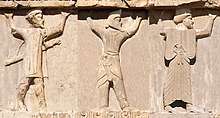
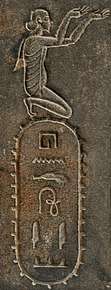



_Upper_Relief_soldiers_with_labels.jpg)
